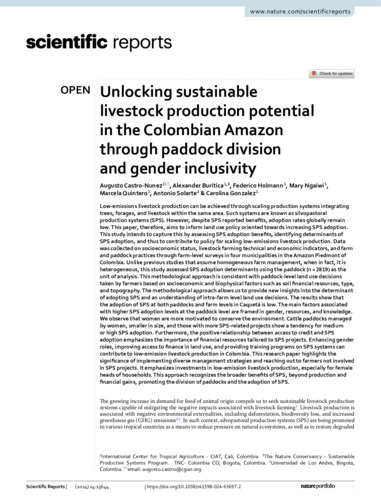Unlocking sustainable livestock production potential in the Colombian Amazon through paddock division and gender inclusivity
Abstract
Low‑emissions livestock production can be achieved through scaling production systems integratingtrees, forages, and livestock within the same area. Such systems are known as silvopastoralproduction systems (SPS). However, despite SPS reported benefits, adoption rates globally remainlow. This paper, therefore, aims to inform land use policy oriented towards increasing SPS adoption.This study intends to capture this by assessing SPS adoption benefits, identifying determinants ofSPS adoption, and thus to contribute to policy for scaling low‑emissions livestock production. Datawas collected on socioeconomic status, livestock farming technical and economic indicators, and farmand paddock practices through farm‑level surveys in four municipalities in the Amazon Piedmont ofColombia. Unlike previous studies that assume homogeneous farm management, when in fact, it isheterogeneous, this study assessed SPS adoption determinants using the paddock (n = 2819) as theunit of analysis. This methodological approach is consistent with paddock‑level land use decisionstaken by farmers based on socioeconomic and biophysical factors such as soil financial resources, type,and topography. The methodological approach allows us to provide new insights into the determinantof adopting SPS and an understanding of intra‑farm level land use decisions. The results show thatthe adoption of SPS at both paddocks and farm levels in Caquetá is low. The main factors associatedwith higher SPS adoption levels at the paddock level are framed in gender, resources, and knowledge.We observe that women are more motivated to conserve the environment. Cattle paddocks managedby women, smaller in size, and those with more SPS‑related projects show a tendency for mediumor high SPS adoption. Furthermore, the positive relationship between access to credit and SPSadoption emphasizes the importance of financial resources tailored to SPS projects. Enhancing genderroles, improving access to finance in land use, and providing training programs on SPS systems cancontribute to low‑emission livestock production in Colombia. This research paper highlights thesignificance of implementing diverse management strategies and reaching out to farmers not involvedin SPS projects. It emphasizes investments in low‑emission livestock production, especially for femaleheads of households. This approach recognizes the broader benefits of SPS, beyond production andfinancial gains, promoting the division of paddocks and the adoption of SPS.

